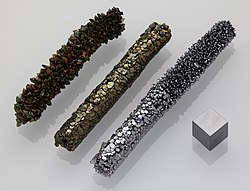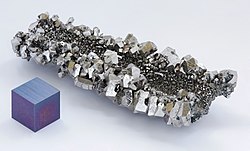
Back Grupo 5 d'a tabla periodica AN عناصر المجموعة الخامسة Arabic Elementos del grupu 5 AST Dövri sistemin 5-ci qrupu Azerbaijani Datu golongan 5 BAN Група 5 на периодичната система Bulgarian পঞ্চম শ্রেণীর মৌল Bengali/Bangla 5. grupa hemijskih elemenata BS Grup 5 de la taula periòdica Catalan 5. skupina Czech
| Group 5 in the periodic table | |||||||||
|---|---|---|---|---|---|---|---|---|---|
| |||||||||
| ↓ Period | |||
|---|---|---|---|
| 4 | Vanadium (V) 23 Transition metal | ||
| 5 | Niobium (Nb) 41 Transition metal | ||
| 6 | Tantalum (Ta) 73 Transition metal | ||
| 7 | Dubnium (Db) 105 Transition metal | ||
|
Legend
| |||
Group 5 is a group of elements in the periodic table. Group 5 contains vanadium (V), niobium (Nb), tantalum (Ta) and dubnium (Db).[1] This group lies in the d-block of the periodic table. This group is sometimes called the vanadium group or vanadium family after its lightest member; however, the group itself has not acquired a trivial name because it belongs to the broader grouping of the transition metals.
As is typical for early transition metals, niobium and tantalum have only the group oxidation state of +5 as a major one, and are quite electropositive (it is easy to donate electrons) and have a less rich coordination chemistry (the chemistry of metallic ions bound with molecules). Due to the effects of the lanthanide contraction, the decrease in ionic radii in the lanthanides, they are very similar in properties. Vanadium is somewhat distinct due to its smaller size: it has well-defined +2, +3 and +4 states as well (although +5 is more stable).
The lighter three Group 5 elements occur naturally and share similar properties; all three are hard refractory metals under standard conditions. The fourth element, dubnium, has been synthesized in laboratories, but it has not been found occurring in nature, with half-life of the most stable isotope, dubnium-268, being only 16 hours, and other isotopes even more radioactive.
- ^ Reich, Herb (2011). Numberpedia: Everything You Ever Wanted to Know (and a Few Things You Didn't) About Numbers. New York: Skyhorse Publishing. p. 512. ISBN 978-1616080846.
© MMXXIII Rich X Search. We shall prevail. All rights reserved. Rich X Search


